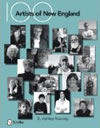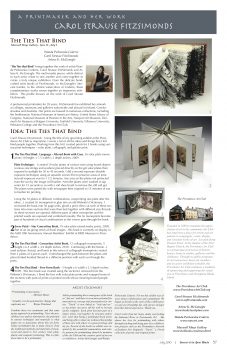Below are listed some of the books, magazines and journals that have recognized Carol’s art with a few works to a feature article.
- Journal of the Print World, “Carol Strause FitzSimonds talks about her Gilded Painted Prints”, January 2013
- 100 Artists of New England by Ashley E. Rooney, 2011
- Journal of the Print World, “A Printmaker and Her Work”, July 2011
- Perdue, Beth, “Artists and art lovers welcome…” Home Gallery Magazine, 2006
- “A Decade of prints”, Janice Steinhagan, Chronicle, Willimantic, CT, July 31, 2003
- Biographical Encyclopedia American Painters, Sculptors & Engravers of the U.S., Colonial to 2002
- Who’s Who in American Art, 1991 – present
- Who’s Who in America, 2013 – present
- Art New England, “The Art/The Artists” Regional Review, Neville, June/July 2001
- Southern Rhode Island Newspapers, “Creative Expressions in Wickford,” Matoney, March 30, 2000
- The Artist’s Magazine, “Exploring Aquatint”, FitzSimonds, October 1999
- New York Times, “Women’s Work, Not All of It Ladylike,” Zimmer, January 24, 1999
- THE BEST OF PRINTMAKING, An International Collection, 1997
- Journal of the Print World, “Engravings and Monotypes at Printmakers Inc., Alexandria, VA,” Spring 1993
- Hollins Magazine, “Hollins Artists,” Fleck, January 1991
- Newport This Week, “The artistic life of a traveling printmaker,” Pantalone, May 4, 1989


Printmaking has come a long Way
Reviewer Mark St. John Erickson
Daily Press, Sunday Dec. 10, 2000
Twentieth Century Gallery, Williamsburg, VA
Carol FitzSimonds’ hand-colored aquatints blend both the old and the new, using a centuries-old etching technique to create a contemporary, often deceptively abstract view of her surroundings.
Working from both photographs and detailed sketches, she explores the world
of old houses, porches, fences and gardens intently, focusing so closely on details of light, shape and shadow that the structures themselves are virtually forgotten.
FitzSimonds’ hand-drawn lines add to the elusive impact of these lush, often mysterious outdoor realms. So does the sensuous progression of aquatint
tones from lightest gray to blackest black, especially after the artist goes back over each image and reinforces this effect through the judicious application of color.
What results are walls of brick, rows of pickets and even clumps of leaves
that appear charged with an unusual visual energy. Look at them long enough and they begin to move according to some wonderfully elegant yet previously unnoticed rhythms.